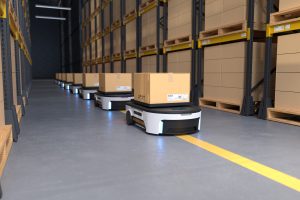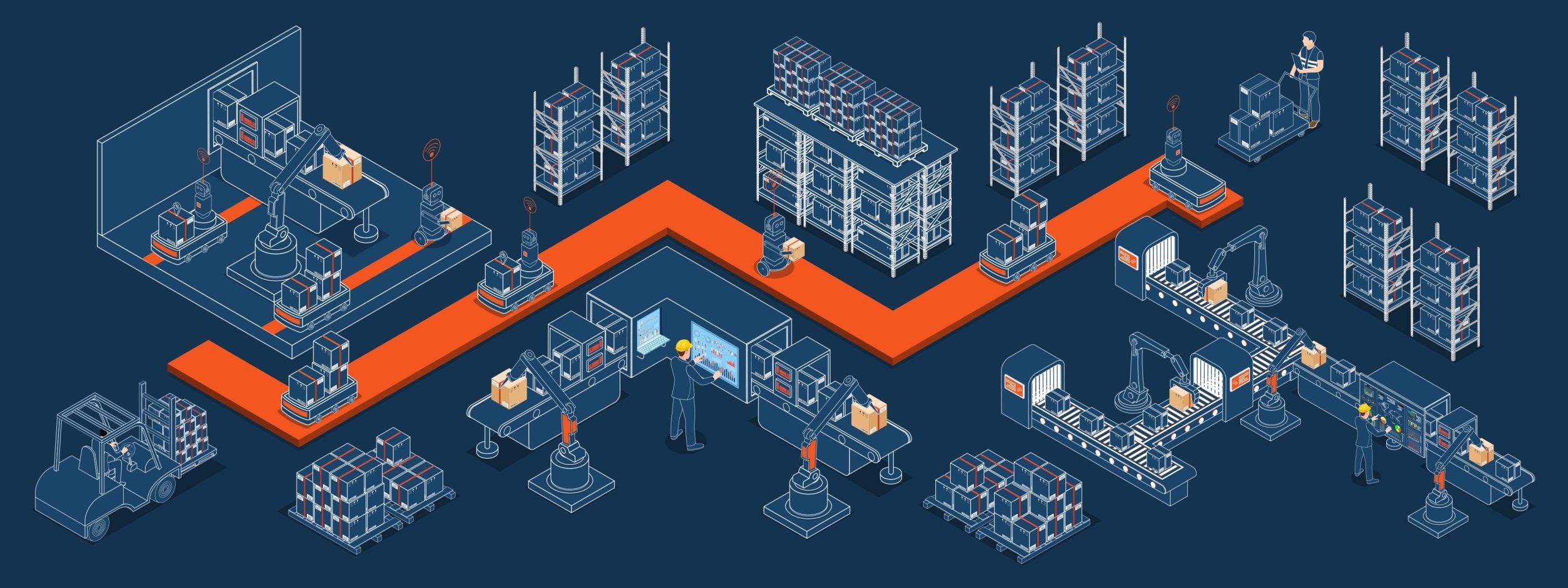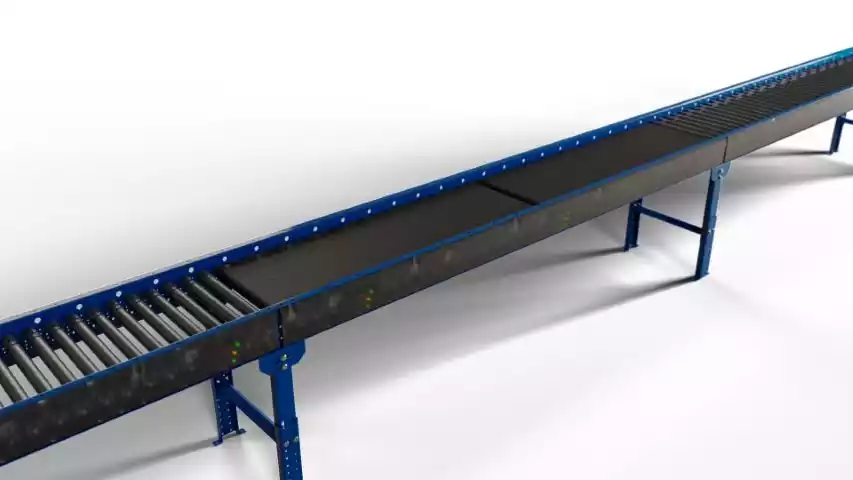Introduction to Efficiency
In the ever-evolving scape of distribution, efficiency isn’t just a buzzword; it’s a necessity. From the humble beginnings of manual labor to the cutting-edge technology of today, the journey of warehousing systems has been nothing short of revolutionary. Let’s delve into the fascinating evolution of distribution efficiency, explore the driving forces behind this trend, and peek into the high-tech world of modern-day warehouses.
How It All Began

In the early days of warehousing, the scene was reminiscent of a bustling hive, with workers darting between towering stacks of crates, manually sorting, lifting, and moving goods. These were the foundational years, where the sweat and toil of laborers defined the pace of operations. However, as industries burgeoned and demands soared, it became increasingly apparent that manual processes could no longer keep pace with the mounting requirements for efficiency and speed.
The advent of mechanized systems marked a pivotal turning point in the history of warehousing and distribution. With the introduction of conveyor belts, pallet jacks, and forklifts, the landscape of warehouses began to transform dramatically. These innovations not only streamlined the movement of goods but also significantly reduced the physical strain on workers. Suddenly, tasks that once required a team of individuals could now be accomplished with relative ease by a single operator controlling a machine.
Moreover, the integration of automated storage and retrieval systems (AS/RS) revolutionized the way warehouses managed inventory. AS/RS utilized computer-controlled systems to automatically place and retrieve goods from designated storage locations, eliminating the need for manual searching and handling. This not only optimized storage space but also enhanced inventory accuracy and tracking, minimizing errors and improving overall operational efficiency.
The evolution of automation didn’t stop there. With advancements in robotics and artificial intelligence, warehouses began incorporating autonomous mobile robots (AMRs) and automated guided vehicles (AGVs) into their workflows. These intelligent machines could navigate warehouse environments autonomously, performing tasks such as picking, packing, and transporting goods with precision and efficiency. By reducing reliance on human intervention for repetitive and labor-intensive tasks, these technologies further elevated productivity while freeing up human workers to focus on more complex and value-added activities.
Furthermore, the emergence of warehouse management systems (WMS) empowered businesses to optimize their entire supply chain operations. These software platforms provided real-time visibility into inventory levels, order statuses, and warehouse activities, enabling managers to make data-driven decisions and respond swiftly to changing demands. By seamlessly integrating with various automation technologies, WMS facilitated the orchestration of tasks and resources, maximizing efficiency and throughput throughout the warehousing and distribution process.
In essence, the journey of automation in warehousing and distribution has been one of continuous innovation and adaptation, driven by the relentless pursuit of efficiency, accuracy, and cost-effectiveness. From humble beginnings marked by manual labor and rudimentary tools to the sophisticated, interconnected ecosystems of today, automation has reshaped the landscape of logistics, paving the way for a future where warehouses operate with unprecedented speed, precision, and agility.
The Evolution Unfolds

In the dynamic landscape of the distribution industry today, the optimization of warehouse automation has emerged as a strategic imperative, especially for retailers aiming to maintain a competitive edge. This imperative is underscored by a convergence of factors, ranging from shifting consumer expectations to the relentless pressure to streamline operations and reduce costs. As the pace of commerce accelerates and e-commerce continues to reshape traditional retail paradigms, businesses are increasingly turning to cutting-edge technologies to enhance efficiency, agility, and responsiveness throughout their supply chain networks.
McKinsey’s insights offer a compelling glimpse into the evolution of automation within the distribution industry, highlighting how it has transcended its status as a mere luxury and evolved into a critical enabler of success. At its core, this evolution is driven by the imperative to adapt to the demands of a rapidly evolving market landscape. Retailers, in particular, are at the forefront of this transformation, leveraging automation technologies to optimize every facet of their warehousing and distribution operations.
One of the most notable trends in this evolution is the proliferation of robotics and AI-driven solutions. From autonomous picking robots to intelligent sorting systems, these technologies are revolutionizing the way goods are handled, processed, and dispatched within warehouses. By augmenting human capabilities with machine intelligence, businesses can achieve unprecedented levels of efficiency, accuracy, and speed in their operations. Moreover, these technologies enable retailers to adapt quickly to fluctuations in demand, scale operations rapidly, and deliver superior customer experiences.
Another key aspect of this evolution is the integration of data analytics and machine learning algorithms into warehouse management systems. By harnessing the power of big data, retailers can gain deep insights into their operations, identify inefficiencies, and optimize processes in real-time. Predictive analytics capabilities allow businesses to anticipate demand patterns, optimize inventory levels, and proactively mitigate risks, enabling them to operate with greater agility and resilience in an increasingly volatile marketplace.
Furthermore, the rise of interconnected ecosystems and collaborative robotics is reshaping the dynamics of warehousing and distribution. Collaborative robots, or cobots, work alongside human operators, assisting them in tasks that require precision, strength, or endurance. By fostering synergy between humans and machines, these technologies not only enhance productivity but also improve workplace safety and ergonomics.
In essence, the evolution of automation in the distribution industry is a testament to the transformative power of technology in reshaping traditional business models. By embracing cutting-edge solutions, retailers can unlock new levels of efficiency, agility, and competitiveness, positioning themselves for success in the fast-paced, digitally-driven economy of the 21st century. As McKinsey’s insights illuminate, automation is no longer a luxury but a strategic imperative for modern businesses seeking to thrive in an ever-evolving marketplace.
Why It's A Trend
The rise of online shopping in recent years has fundamentally transformed consumer expectations, ushering in an era where convenience and speed are paramount. As e-commerce giants like Amazon have raised the bar with their promise of next-day delivery, competitors across industries are finding themselves under immense pressure to keep pace. In response to this seismic shift in consumer behavior, the distribution industry has witnessed a rapid acceleration in the adoption of automation technologies. This trend isn’t merely about maximizing throughput to boost the bottom line; rather, it’s a strategic imperative for businesses looking to remain competitive in an increasingly cutthroat market.
Automation has become the cornerstone of modern distribution operations, revolutionizing every aspect of the supply chain from warehousing to last-mile delivery. At the heart of this transformation lies the quest for efficiency and agility. By leveraging automation, businesses can optimize processes, minimize errors, and respond swiftly to fluctuations in demand. This is particularly crucial in the context of e-commerce, where order volumes can fluctuate dramatically and customer expectations for rapid delivery are sky-high.
One of the most prominent manifestations of automation in the distribution industry is the widespread adoption of robotic systems. Autonomous mobile robots (AMRs) are increasingly being deployed in warehouses and fulfillment centers to automate tasks such as picking, packing, and sorting. These robots navigate the facility autonomously, optimizing the flow of goods and minimizing the need for human intervention. By streamlining these labor-intensive processes, businesses can achieve significant gains in productivity and operational efficiency.
Furthermore, the integration of artificial intelligence (AI) and machine learning algorithms is revolutionizing predictive analytics and demand forecasting in the distribution industry. By analyzing vast troves of data, AI-powered systems can identify patterns, trends, and anomalies, enabling businesses to make more informed decisions and anticipate future demand with greater accuracy. This not only reduces the risk of stockouts and overstock situations but also ensures that resources are allocated more efficiently, driving down costs and improving overall profitability.
Moreover, automation is reshaping the landscape of last-mile delivery—the final frontier in the quest for faster, more convenient shipping options. Drones, autonomous delivery vehicles, and smart lockers are increasingly being deployed to streamline the delivery process and enhance the customer experience. By leveraging these technologies, businesses can reduce delivery times, minimize transportation costs, and offer greater flexibility and convenience to consumers.
In essence, automation has become a defining trend in the distribution industry, reshaping the way businesses operate and compete in the digital age. By embracing automation technologies, companies can not only maximize throughput and efficiency but also meet the ever-evolving demands of today’s discerning consumers. As the race for faster, more convenient delivery options heats up, automation will undoubtedly remain at the forefront of innovation in the distribution industry, driving continued growth and competitiveness in the years to come.
Navigating Challenges

As the distribution industry strives for greater efficiency through automation, it encounters a myriad of challenges along the way. Foremost among these challenges is the looming specter of labor shortages, which has become a pervasive concern across industries. The traditional reliance on manual labor is no longer sustainable in the face of evolving workforce dynamics, demographic shifts, and changing attitudes toward work. This necessitates a fundamental rethink of traditional workflows and operational paradigms, as businesses grapple with the urgent need to adapt to a shrinking pool of available workers.
However, amidst these challenges, the promise of substantial return on investment (ROI) acts as a powerful beacon of hope, compelling businesses to forge ahead with their automation initiatives despite the initial costs involved. Warehouse Automation: The Drivers, the Barriers, and the Trends for 2023, offers valuable insights into navigating these challenges and unlocking the full potential of automation in the distribution industry.
One of the primary drivers behind the adoption of automation is the pressing need to mitigate the impact of labor shortages on operational efficiency. By automating repetitive and labor-intensive tasks, businesses can reduce their reliance on human workers and alleviate the strain on existing personnel. This not only helps address immediate staffing challenges but also future-proofs operations against potential fluctuations in the labor market.
Moreover, automation offers a pathway to greater scalability and flexibility in warehouse operations. With automated systems in place, businesses can adapt more swiftly to changes in demand, scale operations up or down as needed, and respond dynamically to market fluctuations. This agility is essential in today’s fast-paced business environment, where the ability to pivot quickly can mean the difference between success and failure.
However, the journey towards automation is not without its barriers. One of the most significant challenges facing businesses is the complexity and cost of implementing automated systems. From upfront capital investments to ongoing maintenance and training costs, the financial barriers to entry can be substantial. Moreover, integrating automation into existing workflows and legacy systems can be a complex and time-consuming process, requiring careful planning and execution.
Furthermore, there are concerns surrounding the potential impact of automation on the workforce. While automation can help alleviate labor shortages, it also raises questions about job displacement and the future of work. Businesses must navigate these concerns sensitively, taking proactive measures to reskill and upskill their workforce and ensure that automation complements rather than replaces human labor.
In conclusion, the journey towards greater efficiency through automation in the distribution industry is fraught with challenges, from labor shortages to financial barriers and workforce concerns. However, by embracing automation as a strategic imperative and leveraging insights from industry research and best practices, businesses can navigate these challenges effectively and unlock the full potential of automation to drive growth, innovation, and competitiveness in the years to come.
The Modern Warehouse

Today’s warehouses stand as monuments to the transformative power of automation, representing a quantum leap from their predecessors in terms of efficiency, accuracy, and scalability. At the heart of this evolution lies a sophisticated ecosystem of control systems, each playing a pivotal role in orchestrating the symphony of automation that defines modern warehouse operations. Warehouse Control Systems (WCS) and Warehouse Management Systems (WMS) stand as twin pillars, seamlessly integrating with one another to form the backbone of warehouse automation.
Warehouse Management Systems (WMS) serve as the digital nerve center of the modern warehouse, providing real-time visibility into inventory levels, order statuses, and operational performance. These robust software platforms leverage advanced algorithms and predictive analytics to optimize inventory placement, streamline order fulfillment, and synchronize the flow of goods throughout the facility. From receiving to shipping, WMS empowers businesses to manage every aspect of their warehouse operations with unparalleled efficiency and precision.
Complementing the capabilities of WMS are Warehouse Control Systems (WCS), which specialize in managing the intricacies of automation equipment and material handling systems. WCS acts as the conductor of the warehouse orchestra, coordinating the movements of conveyor belts, automated storage and retrieval systems (AS/RS), robotic arms, and other robotic technologies with precision timing and sequencing. By interfacing directly with automation hardware and translating higher-level directives from WMS into actionable commands, WCS ensures smooth and seamless execution of tasks, maximizing throughput and minimizing delays.
Taking automation to the next level, Warehouse Execution Systems (WES) represent the pinnacle of optimization in modern warehouses. These advanced systems bridge the gap between digital planning and physical execution, leveraging real-time data and machine learning algorithms to dynamically optimize work processes on the warehouse floor. From task allocation and resource scheduling to route optimization and workload balancing, WES harnesses the power of automation to drive continuous improvement and operational excellence.
Moreover, the advent of Internet of Things (IoT) technologies is further revolutionizing the modern warehouse, enabling seamless connectivity and data exchange between physical assets and digital systems. IoT sensors embedded in equipment, shelves, and even products themselves provide granular visibility into every aspect of warehouse operations, facilitating predictive maintenance, inventory tracking, and asset optimization.
In essence, automation has become the linchpin of the modern warehouse, reshaping the way businesses manage and operate their distribution facilities. By harnessing the collective power of WMS, WCS, WES, and IoT technologies, warehouses can achieve unprecedented levels of efficiency, agility, and responsiveness, positioning themselves for success in an increasingly competitive and dynamic marketplace. As the march of technology continues unabated, the future promises even greater advancements in automation, paving the way for a new era of warehouse innovation and excellence.
Embracing Automation
Conveyors, sortation systems, AS/RS, AGVs, AMRs, robotic cells—the arsenal of automation tools is vast and varied. From end-of-line packaging to pick-and-put systems, each component plays a vital role in the quest for efficiency. Smart factories, with their fully autonomous setups, represent the pinnacle of this evolution, promising unparalleled efficiency with minimal human intervention.
Conclusion
At Russell Conveyor & Equipment, we understand the importance of efficiency in the distribution industry. Our role in this evolution isn’t just about providing equipment; it’s about fostering strategic partnerships that pave the way for turnkey solutions. As the landscape continues to evolve, we remain committed to pushing the boundaries of innovation, driving efficiency, and shaping the future of distribution.
In conclusion, the journey of efficiency in the distribution industry is a testament to human ingenuity and technological advancement. From humble beginnings to high-tech marvels, the evolution of warehousing systems reflects our relentless pursuit of optimization. As we navigate the challenges of today and embrace the opportunities of tomorrow, one thing remains clear: the quest for efficiency knows no bounds.





